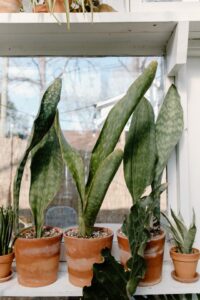If you are a foliage plant enthusiast, you cannot afford to miss the snake plant, which is also known as Bowstring Hemp Plant, Mother in Law Tongue, or Devil’s Tongue. This notable plant is botanically known as the Dracaena trifasciata, but most popular from its common name. It was formerly Sansevieria trifasciata. Contemporary, the plant is having a high demand as an ornamental plant. You can adapt it as an outdoor plant in warmer climates. Simultaneously, try it as an indoor plant in cooler climates. Beginner gardeners prefer this plant due to its outstanding appearance and easy care. Here we give you several important tips about the snake plant.

What is the snake plant and how does it look?
The plant belongs to the family Asparagaceae and is an evergreen perennial. The plant has originated in the African region and is native to the tropic. It is hard to miss their green banded leaves with a frequent yellow color border. Leaves can grow up to several feet in height and have a stiff and sword-like temperament. The plant also provides a white color, spring bloom.
What are the benefits of snake plant?
Unlike some plants that we grow for their look, snake plants come with several benefits.
- Purify indoor air
This plant can convert carbon dioxide into oxygen and thereby provide you with fresh air to breathe. You can grow the plant indoors.

- Remove toxic pollutants
Snake plants can remove toxic air pollutants. This is an awesome advantage for modern and urban households to maintain the sound domestic air quality. The plant absorbs benzene, formaldehyde, xylene, and toluene-like pollutants, which are known to cause cancers. This purifying ability acts as a barrier against airborne allergies.
- Charming appearance
Other than the health benefits, plants exclude a strange charm and bring nature inside your home.
- Protective energy and Feng Shui
Although some tend to believe that the snake plant gives off negative energy, the majority believe that placing it in the right position helps you with blocking negative energy and bringing protective and purifying energy. It is better to plant it in the Southeastern, Southern, and Eastern corners of your garden.
- Low maintenance and easy care
Growing a snake plant from a cutting is super easy. You can also choose to divide your plant from its root and to plant it separately as a new, individual plant. The plant will easily grow either in a pot or direct soil. But be careful to provide well-draining soil to avoid rotting and maintain a dry period between the watering. The plant can survive under low light, tolerate drought, and have little pest and disease problems. General-purpose fertilizer is more than enough to provide sound nutrition balance for the plant.

Are snake plants poisonous?
Despite offering numerous benefits, sometimes you need to be careful with the snake plant. It is poisonous to ingest. When ingested, it may cause nausea and vomiting. It also has a numbing effect and makes your tongue and throat swell. If the plant juice comes in contact with the skin, you need to be alert of dermatitis.
If your household has some pets like cats and dogs, be careful not to let them ingest the snake plant that causes similar problems like nausea and vomiting. A large portion can be fatal to them. This toxicity is caused by saponins; natural insecticides and fungicides.
How many varieties of Snake Plant are there?
There are more than a dozen varieties of snake plants. Among the latter are known to be much popular.

- Sansevieria ‘Golden Hahnii’
This plant is comparatively shorter and has yellow color borders in its leaves.
- Sansevieria cylindrical
This type is known as the cylindrical snake plant. It is different due to the round leaves.
- Sansevieria trifasciata ‘Twist’
The plant has twisted leaves that grow up to a height of around one to two feet and have yellow color edges.
- Rhino Grass
The Sansevieria desertii plant will surprise you with its red-tinted leaves.
- White Snake
The plant has narrow leaves with white vertical stripes.
- Sansevieria fischeri
This is one of the smallest varieties of the snake plant family.
- Sansevieria Ehrenbergii ‘Banana’
This is also a dwarf variety with banana-shaped leaves.
- Sansevieria Zeylanica
The plant has upward-growing leaves with dark and lighter green patterns.
Are snake plants good indoors?
One of the frequently asked questions is “Is snake plant indoor or outdoor?”
Gardeners are eager to grow spider plants; Chlorophytum comosum due to their adaptability and easy-care nature. The plant prefers a temperature range from 13–27°C and is an excellent choice for indoor planting. Just like the snake plant, the spider plant is also known for its purifying ability.

If you think about selecting plants for your garden or the indoor table or bedroom don’t hesitate to go with the tremendous snake plant. It has a unique appearance and gives your garden a different vibe. The plant goes well with indoor arrangements as well. The easy to care and the low maintenance snake plant is a perfect choice that brings you positive energy and protection.


Pingback: Healing To The Body – Comfort To The Mind - Living Happily By Planting Indoor Plants -